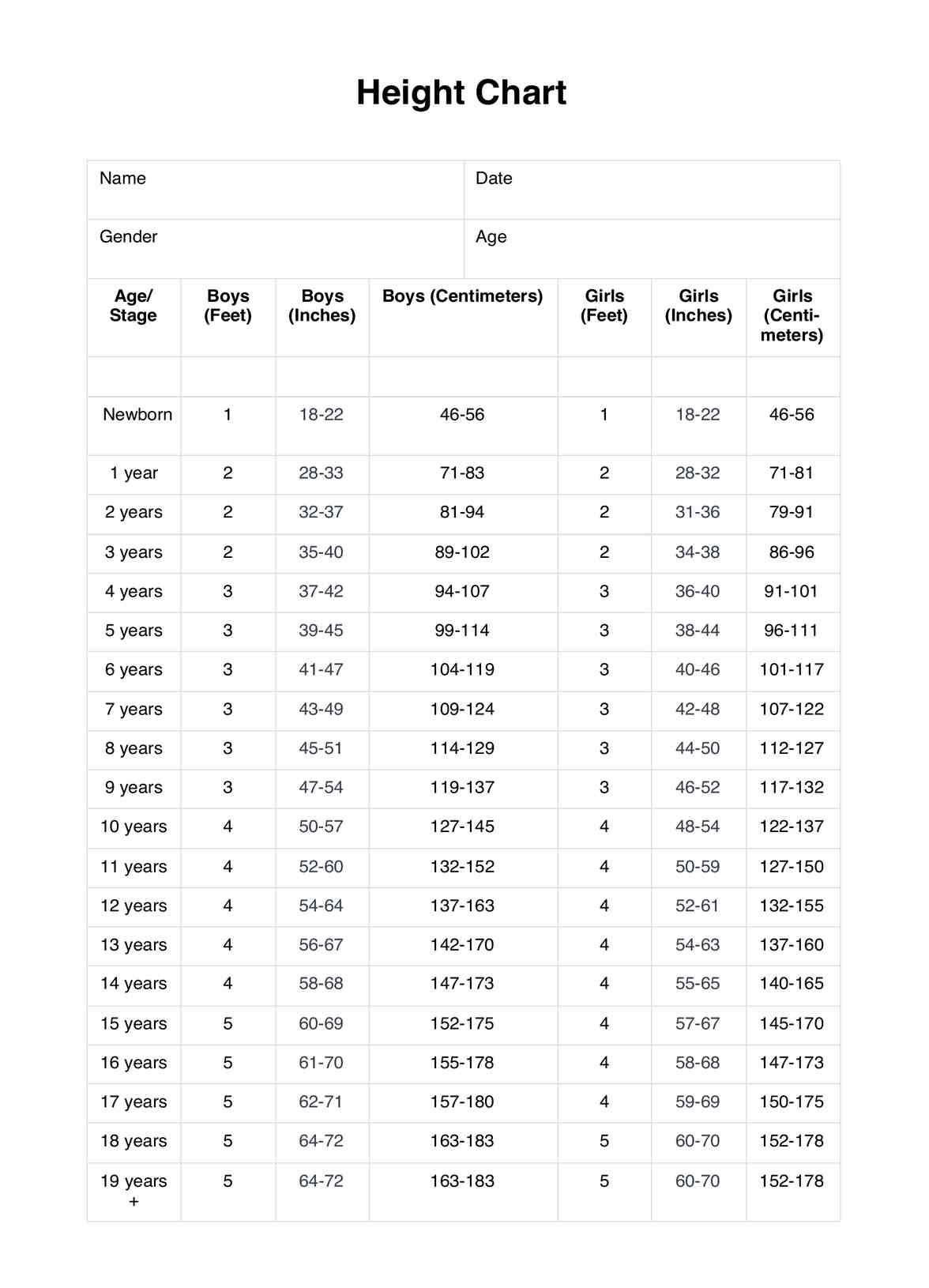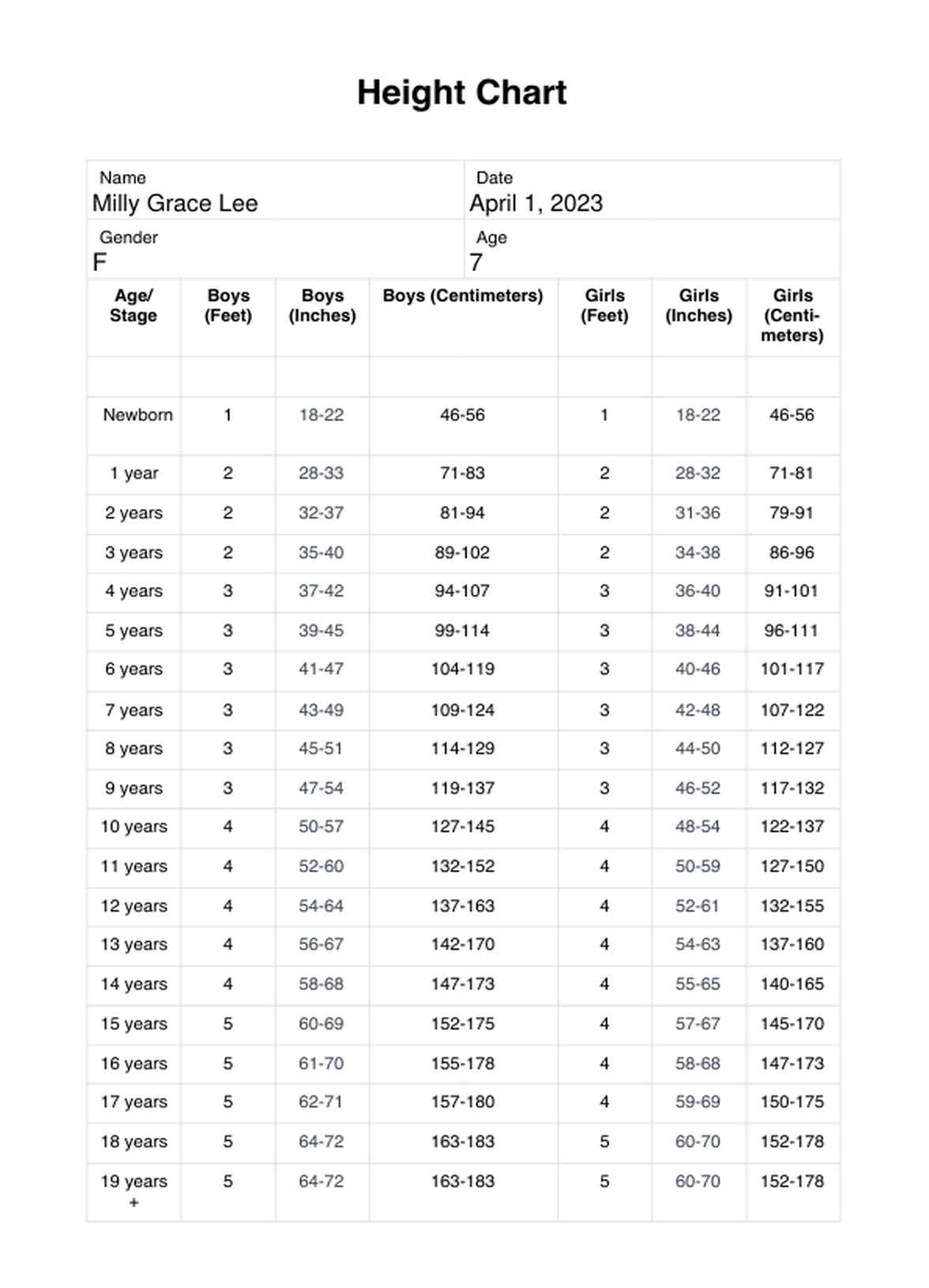Height Chart
Learn more about height charts and the importance of tracking growth. Download the free PDF template and example here.


What is a Height Chart?
A height chart is a simple yet essential tool to track the growth of children, infants, and toddlers. It visually represents the average height range for boys and girls at each age, usually measured in feet and inches or centimeters.
A wall height chart can be found in most pediatricians' offices, nurseries, schools, and even some households. In today's technological era, many websites and apps offer height charts to be downloaded or printed for personal use.
Healthcare professionals use this tool to monitor a child's height and compare it to the average height of children in their age group. This comparison can help identify potential growth issues early on and allow for timely intervention if necessary.
A detailed baby height chart may include weight, head circumference, and body mass index (BMI) information. However, the main focus is tracking height to ensure proper growth and development.
Height Chart Template
Height Chart Example
The importance of tracking height and growth
A child's height is crucial to their overall health and well-being (More Than Height, n.d.). A steady growth rate is necessary for healthy bone, muscle, and brain development during infancy and childhood (Office of the Surgeon General [US], 2004).
Here are several reasons why tracking a child's height is essential:
- Identify growth patterns: By comparing a child's height to the average, you can identify any abnormal growth patterns and take appropriate action.
- Monitor overall health: A sudden change in a child's growth can indicate underlying health issues. Tracking height helps keep tabs on their overall well-being.
- Predict future growth: A child's height during the first year of life can predict their potential adult height, although genetics also play a significant role.
- Check for malnutrition or overnutrition: Extreme heights (too tall or short) may indicate malnutrition or overnutrition.
- Evaluate effectiveness of treatment: For children with growth-related conditions, tracking height regularly helps evaluate the effectiveness of treatment and make necessary adjustments.
The average height for kids and comparison with adults
On average, a baby grows about 20 inches (50 centimeters) during the first year of their life (Healthline, 2022). From ages 1 to 6, children experience an average growth rate of about 2½ inches (6 centimeters) per year (KidsHealth, 2023). However, it's important to note that every child is unique, and there can be significant variations in growth patterns.
This is why it is crucial to regularly track a child's height and compare it with the expected growth for their age and gender. By keeping a close eye on their growth, parents and healthcare professionals can ensure that the child is developing appropriately.
As children grow older, the differences in growth between boys and girls become more noticeable. By age 8, boys typically start surpassing girls in height, which continues throughout childhood. According to the Centers for Disease Control and Prevention, the average height for boys at this age is around 51.5 to 54.5 inches (131 to 138 centimeters).
The average height for girls of the same age is 47 to 54 inches (120 to 138 centimeters) (Cincinnati Children's Hospital Medical Center, n.d.). This pattern of boys being taller than girls continues as they grow older (Costa, Blumenberg, and Victora,2021; Zheng et al., 2013), with boys being about 2 inches (5 centimeters) taller than girls by the time they reach adolescence
Understanding these growth patterns and differences can help parents and caregivers better support a child's development and provide appropriate guidance as they navigate through different stages of growth.
Types of height charts
Different height charts are available, including wall and stick-on height charts. They have different designs and features, but the basic concept is the same – to track a child's height over time.
- Wall height charts are usually made of wood or plastic and can be hung on a wall in the nursery or child's bedroom. Some even have wooden kids ' height chart markers that can be moved as the child grows.
- Stick-on height charts, on the other hand, are usually made of vinyl and can easily be stuck to a wall. They often come with fun designs that kids will love, making it more exciting for them to track their growth.
- Baby height charts are specifically designed for newborns and infants. They usually have smaller increments, allowing more accurate tracking of a baby's growth during their first year.
- Personalized height charts are becoming increasingly popular as they can be customized with a child's name or photos. This adds a personal touch and makes it more special for the child to track their growth.
How to use Carepatron's free Height Chart
Our free Height Chart template provides detailed information about a child's height in feet, inches, and centimeters. The chart is designed to be a reference when measuring a child's height and tracking their growth progress. Here's how to use the template:
Step 1: Download the Height Chart
Get a copy of the printable template using the link on this page. You can also download it from the Carepatron app or our resources library.
Step 2: Print or use the digital format
Print the chart on an A4 paper or use it digitally by saving it in a suitable format and editing each time you need to record height. The template also has a section for findings and recommendations, making adding notes after each measurement easy.
Step 3: Measure and record the child's height
Measure the child's height using a wall height chart or stand-alone height measurement stick. Then, find the corresponding age on the chart and mark it. You can repeat the process regularly to track a child's growth over time.
Step 4: Compare and analyze
Use the chart to compare the child's height with a peer group or previous measurements. This allows you to see if there are any significant changes in their growth pattern. If there are any sudden changes, it is important to note them and discuss them with the parents or guardians.
What is the difference between a Height Chart and a Height Weight Chart?
A height or growth chart is essential for meticulously tracking a child's height progression. It provides valuable information for parents, doctors, and caregivers to monitor and assess a child's physical development.
In addition to tracking height, a height-weight chart offers a comprehensive view of a child's growth and overall well-being by considering their weight.
Both charts are crucial in understanding a child's growth pattern, serving distinct purposes. A height chart allows for effortlessly comparing a child's height with their peers, offering insights into their relative growth rate and potential growth spurts.
On the other hand, a height weight chart provides a broader perspective by incorporating weight data, enabling a more comprehensive assessment of a child's overall health and development.
By utilizing both height and height weight charts together, you can better understand the child's growth trajectory and identify potential areas of concern.
When should I use this template?
You can use this height chart template for various purposes, such as tracking a child's growth during regular check-ups, monitoring the effectiveness of treatment plans for height-related conditions, or simply keeping track of a child's growth at home.
Let’s take a look at how this template can be used in different scenarios:
Regular check-ups
As a healthcare professional, you may use this height chart during routine check-ups to track and compare a child's growth with previous measurements. This can help identify potential issues or deviations from the expected growth pattern.
For treatment plans
Some children may require treatment for height-related conditions, such as growth hormone deficiency or delayed puberty. This template can be used to monitor the effectiveness of these treatments and make necessary adjustments if needed.
Comparing growth between boys and girls
You can also use this template to compare the growth of boys and girls in a particular age group. This can offer valuable insights into potential differences in gender growth patterns.
At home
Parents can also use this height chart at home to track their child's growth and development. It can help identify any concerns and seek medical advice if necessary.
References
Centers for Disease Control and Prevention. (n.d.). Growth chart [PDF]. https://www.cdc.gov/growthcharts/data/set2/chart-08.pdf
Cincinnati Children's Hospital Medical Center. (n.d.). Normal Growth. Cincinnati Children's Hospital Medical Center. Retrieved from https://www.cincinnatichildrens.org/health/g/normal-growth
Costa, J. C., Blumenberg, C., & Victora, C. (2021). Growth patterns by sex and age among under-5 children from 87 low-income and middle-income countries. BMJ Global Health, 6, e007152.
Healthline. (2021, August 15). Average Baby Length. https://www.healthline.com/health/parenting/average-baby-length
KidsHealth. (2023, December 15). Child's Growth. https://kidshealth.org/en/parents/childs-growth.html
More Than Height. (n.d.). Height and Health. More Than Height. https://www.morethanheight-us.com/height-and-health.html
Office of the Surgeon General (US). (2004). Bone Health and Osteoporosis: A Report of the Surgeon General (Chapter 6: Determinants of Bone Health). Rockville, MD: Office of the Surgeon General (US). Retrieved from https://www.ncbi.nlm.nih.gov/books/NBK45503/
Zheng, W., Suzuki, K., Yokomichi, H., Sato, M., & Yamagata, Z. (2013). Multilevel longitudinal analysis of sex differences in height gain and growth rate changes in Japanese school-aged children. Journal of Epidemiology, 23(4), 275-279. https://doi.org/10.2188/jea.je20120164
Commonly asked questions
To read a height chart, you first need to understand the units of measurement used. Most commonly, height charts use feet and inches or centimeters. It is common for children under two years old to use baby height charts that measure in inches or centimeters.
The best marker for wooden growth charts would be a permanent marker. This will ensure that the measurements and marks on the chart do not fade or smudge over time. You can also use stickers or vinyl decals to mark the chart, but make sure they are durable and long-lasting.
Yes! You can add sections and more data to the Height Chart template to suit your practice's needs. This is especially useful to track other growth factors such as head circumference, weight, or BMI.














































































































